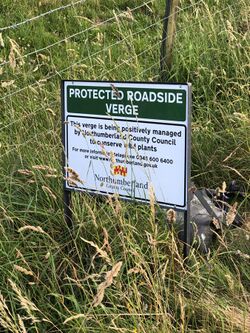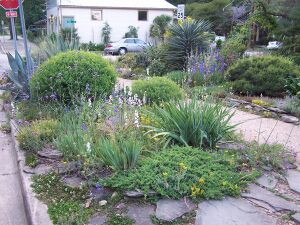Engineering:Road verge

A road verge is a strip of groundcover consisting of grass or garden plants, and sometimes also shrubs and trees, located between a roadway and a sidewalk.[1] Verges are known by dozens of other names such as grass strip, nature strip or curb strip, the usage of which is often quite regional.
Road verges are often considered public property, with maintenance usually being a municipal responsibility. Some local authorities, however, require that abutting property owners to help maintain (e.g. watering, mowing, edging, trimming/pruning and weeding) their respective verge areas, as well as clean the adjunct footpaths and gutters,[2] as a form of community work.
Benefits of having road verges include visual aesthetics, increased safety and comfort of sidewalk users, protection from spray from passing vehicles, and a space for benches, bus shelters, street lights, and other public amenities. Verges are also often part of sustainability for water conservation or the management of urban runoff and water pollution[3][4][5] and can provide useful wildlife habitat. Snow that has been ploughed off the street in colder climates often is stored in the area of the verge by default.[citation needed]
In the British Isles, road verges serve as important habitats for a range of florae, including rare wildflowers.[6] In the UK, around 700 different species of wildflower can be found growing on verges, including 29 of the country's 52 species of orchid.[7] Verges can also support a wide range of animals and plants that may have been displaced from their usual grassland habitats, as the soil is not extensively fertilised and relatively undisturbed by human activity. Animals that reside on verges range from small insects and amphibians, to larger reptiles, mammals and birds, which rely on verges as a corridor connecting areas of undamaged habitat. As a result, verges may be managed by local areas to encourage biodiversity and conserve the ecosystems that rely on them.[7]
The main disadvantage of a road verge is that the right-of-way must be wider, increasing the cost of the road. In some localities, a wider verge offers opportunity for later road widening, should the traffic usage of a road demand this. For this reason, footpaths are usually sited a significant distance from the curb.[citation needed]
Certain nutrient amounts in a verge's soil can be influenced by the amount of traffic on the road it sits beside; roads with heavier traffic tend to have more nitrate in the soil due to nitrogen compounds from air pollution leaching out of the atmosphere and into the ground.[7]
Sustainable urban and landscape design
In urban and suburban areas, urban runoff from private and civic properties can be guided by grading and bioswales for rainwater harvesting collection and bioretention within the "tree-lawn" – parkway zone in rain gardens. This is done for reducing runoff of rain and domestic water: for their carrying waterborne pollution off-site into storm drains and sewer systems; and for the groundwater recharge of aquifers.[3]
In some cities, such as Santa Monica, California, city code mandates specify:
Parkways, the area between the outside edge of the sidewalk and the inside edge of the curb which are a component of the Public Right of Way (PROW) – that the landscaping should require little or no irrigation and the area produce no runoff.[4]
For Santa Monica, another reason for this use of "tree-lawns" is to reduce current beach and Santa Monica Bay ocean pollution that is measurably higher at city outfalls. New construction and remodeling projects needing building permits require that landscape design submittals include garden design plans showing the means of compliance.[4]
In some cities and counties, such as Portland, Oregon , street and highway departments are regrading and planting rain gardens in road verges to reduce boulevard and highway runoff. This practice can be useful in areas with either independent Storm sewers or combined storm and sanitary sewers, reducing the frequency of pollution, treatment costs, and released overflows of untreated sewage into rivers and oceans during rainstorms.[8]
Rural roadsides
In some countries, the road verge can be a corridor of vegetation that remains after adjacent land has been cleared. Considerable effort in supporting conservation of the remnant vegetation is prevalent in Australia, where significant tracts of land are managed as part of the roadside conservation strategies by government agencies.[9][10]
Gallery
Ginkgo street trees in the "boulevard" area, in Riverside, Illinois
Terminology
The term verge has many synonyms and dialectal differences. Some dialects and idiolects lack a specific term for this area, instead using a circumlocution.[11][12]
Terms used include:
- Berm: Pennsylvania, northern Indiana , Ohio, Michigan, Wisconsin, New Zealand[13]
- Besidewalk[14]
- Boulevard: Detroit, Michigan; North Dakota; Minnesota; Iowa; Illinois; Ohio; Wisconsin; United States Upper Midwest;[13] Winnipeg, and western Canada ;[15] Toronto, Ontario;[16] Markham, Ontario; Kitchener, Ontario[17]
- Boulevard strip: U.S. Upper Midwest
- Common: New England, generally describes a large strip of grass. Also refers to park-like common-use green spaces in small town centers.
- Curb lawn: Kalamazoo, Michigan;[18] Elyria, Ohio;[19] Miami County, Ohio;[20] Greenville, South Carolina[21]
- Curb strip: New Jersey, New York, North Carolina, Florida, Ohio, Indiana, Massachusetts , Michigan, Iowa, Kansas , Nebraska, Oregon, Washington (state) [13]
- Devil strip or devilstrip: Akron, Ohio; Northeast Ohio.[22][23][24] This term was once used more widely to refer to the space between tracks on a streetcar line, a space not wide enough to stand in as cars passed.[25]
- Drivestrip or Drive Strip
- Extension lawn: Ann Arbor, Michigan[citation needed]
- Furniture zone, also landscape zone: a term used by urban planners, indicating its suitability for "street furniture" such as utility poles and fire hydrants, as well as trees or planters[26]
- Grassplot: East Coast of the United States, Pennsylvania[13]
- Hellstrip[27]
- Island strip: Long Island, New York[citation needed]
- Long acre – a traditional term for wide grassy road verges, used by grazing herds or flocks moving from place to place
- Median: Washington (state) , Oregon[citation needed]
- Mow strip: SF East Bay Area Northern California
- Nature strip: Australia [28]
- Neutral ground: U.S. Gulf states[13][29]
- Park strip: Ohio[1]
- Parking: Illinois, Iowa, Western United States[13]
- Parking strip: Washington (state) , Oregon, Utah, much of California [13]
- Parkrow: Iowa, Oregon[30]
- Parkway: Grand Rapids, Michigan; Greater Los Angeles; San Francisco Bay Area; West Coast of the United States; Casper, Wyoming; Ohio; Illinois; Missouri; Florida; Texas [13][31][32]
- Parkway strip: Austin, Texas ; Fort Collins, Colorado[33]
- Planter zone: SmartCode/New Urbanist terminology[34]
- Planting strip: Berkeley, California,[35] Seattle, Washington[36]
- Right-of-way: Wisconsin, Illinois
- Road allowance: Ottawa, Canada[37]
- Road verge: Australia [38][unreliable source?]
- Roadside: Australia[9]
- Shoulder [39]
- Sidewalk lawn: Georgia[40]
- Sidewalk plot: Virginia, Maryland, Indiana , Tennessee [13]
- Sidewalk strip: California , North Carolina, Oregon, Utah, Washington (state) [citation needed]
- Sidewalk taint: Central Indiana
- Street lawn: Ohio[1]
- Subway: Western New York[citation needed]
- Swale: South Florida[41]
- Terrace: U.S. Great Lakes region, Missouri[13]
- Tree belt: Massachusetts [13]
- Tree box: Washington, DC[42]
- Tree lawn or treelawn: Ohio, Indiana, New York, and elsewhere[13][31][43]
- Verge: UK,[6] New Zealand, South Africa ,[44] Western Australia[45][31]
See also
- Central reservation
- Roadside conservation
- Shoulder (road)
- Urban forestry
References
- ↑ 1.0 1.1 1.2 "Street Trees / Tree Lawn". Worthington. City of Worthington, Ohio. http://www.worthington.org/index.aspx?NID=299.
- ↑ "Designing Sidewalks and Trails for Access, Part II of II: Best Practices Design Guide, Section 10.1.3: Maintenance responsibilities". Bicycle and Pedestrian Program. Federal Highways Administration, U.S. Department of Transportation. 25 September 2017. https://www.fhwa.dot.gov/environment/bicycle_pedestrian/publications/sidewalk2/sidewalks210.cfm.
- ↑ 3.0 3.1 Delost, Jeremy (19 September 2009). "Passive Rainwater Harvesting". The Rainwater Observer. http://www.rainwatercollecting.com/blog/?p=448.
- ↑ 4.0 4.1 4.2 Parkway Landscaping Policy for the City of Santa Monica, City of Santa Monica, California, 1 February 2010, http://www.smgov.net/uploadedFiles/Departments/OSE/Categories/Landscape/PLP%2005.27.09.pdf, retrieved 7 July 2010
- ↑ "Pruning the Parkway Strip". WaterWise 4 (3). 14 March 2007. http://www.enewsbuilder.net/watercon/e_article000771115.cfm?x=bbrDcbK,b2FRwTrq,w. Retrieved 7 July 2010.
- ↑ 6.0 6.1 Briggs, Helen (6 June 2015). "Roadside verges 'last refuge for wild flowers'". BBC News. https://www.bbc.com/news/science-environment-33029385.
- ↑ 7.0 7.1 7.2 "Why road verges are important habitats for wildflowers and animals" (in en). https://www.nhm.ac.uk/discover/why-road-verges-are-important-wildlife-habitats.html.
- ↑ "Sustainable Stormwater Management". http://www.portlandonline.com/BES/index.cfm?c=34598.
- ↑ 9.0 9.1 "Roadside Conservation Values". Indigo Shire Council. Indigo Shire Council. 2007. http://www.indigoshire.vic.gov.au/residents/natural-resource-management/roadside-management/roadside-conservation-values/index.html.
- ↑ Western Australia. Roadside Conservation Committee (1995), Roadsides -- the vital link : a decade of roadside conservation in Western Australia (1985-1995), Roadside Conservation Committee, http://trove.nla.gov.au/work/23235561, retrieved 2012-04-14
- ↑ Greppin, John A. C. (1 February 2002). "The triumph of slang". The Times Literary Supplement (Times Newspapers Limited). https://www.the-tls.co.uk/articles/private/the-triumph-of-slang/.
- ↑ "What do you call the area of grass between the sidewalk and the road? (Harvard Dialect Survey)". http://dialect.redlog.net/staticmaps/q_60.html.
- ↑ 13.00 13.01 13.02 13.03 13.04 13.05 13.06 13.07 13.08 13.09 13.10 13.11 Hall, Joan Houston, ed (2013). Dictionary of American Regional English, Volume VI: Contrastive Maps, Index to Entry Labels, Questionnaire, and Fieldwork Data (1st ed.). Harvard University Press. ISBN 978-0674066533. https://archive.org/details/dictionaryofamer0000unse_a4m8.[page needed]
- ↑ "Between the sidewalk and the curb". The Atlantic. 7 December 1998. https://www.theatlantic.com/past/docs/unbound/fugitives/sidewalk.html.
- ↑ Boulevard Gardening Guidelines, City of Vancouver , British Columbia, http://vancouver.ca/files/cov/boulevard-gardening-guidelines.pdf, retrieved 28 October 2017
- ↑ "TORONTO MUNICIPAL CODE CHAPTER 743, STREETS AND SIDEWALKS, USE OF". June 11, 2020. https://www.toronto.ca/legdocs/municode/1184_743.pdf.
- ↑ "Standard Specifications, City of Kitchener". https://www.kitchener.ca/en/resourcesGeneral/Documents/DSD_ENG_C-of-K---Standard-Specifications_November-2017.pdf.
- ↑ "Departments : Public Services : Public Works : Fall Leaf Collection". City of Kalamazoo. http://www.kalamazoocity.org/portal/pubserve.php?page_id=312.
- ↑ Rona Proudfoot (March 26, 2012). "Police find man dead in curb lawn". The Chronicle-Telegram. http://chronicle.northcoastnow.com/2012/03/26/police-find-man-dead-in-curb-lawn/.
- ↑ "Who Do I Call?". City of Troy. http://www.troyohio.gov/whotocall.html.
- ↑ "Design and Specifications Manual". City of Greenville. 2012. http://www.greenvillesc.gov/publicworks/EngineeringDSM.aspx.
- ↑ "Mr. Smarty Pants". The Austin Chronicle. 2000-12-29. http://www.austinchronicle.com/gyrobase/Issue/column?oid=oid%3A79961.
- ↑ Cassidy, Frederic Gomes; Hall, Joan Houston (1985). Dictionary of American Regional English: Introduction and A-C (6th ed.). Harvard University Press. p. 55. ISBN 978-0-674-20511-6. https://archive.org/details/dictionaryofamer01arie. Retrieved 2009-03-20. "devil strip."
- ↑ Dyer, Bob (August 8, 2012). "Akron's Grass is One of a Kind". Akron Beacon Journal. http://www.ohio.com/news/dyer/bob-dyer-akron-s-grass-is-one-of-a-kind-1.325843.
- ↑ Hilton, George W.; Due, John F. (1960). The Electric Interurban Railways in America. Stanford University Press. p. 51. ISBN 978-0-8047-4014-2. https://archive.org/details/electricinterurb00hilt.
- ↑ (PDF) Foster Road Transportation & Streetscape Plan, Office of Transportation, City of Portland, Oregon, 9 July 2003, pp. 10–12 and 14–15, http://www.portlandoregon.gov/transportation/article/370416
- ↑ Hadden, Evelyn (2014). Hellstrip Gardening: Create a Paradise between the Sidewalk and the Curb. Photography by Joshua McCullough. Timber Press. ISBN 978-1604693324.
- ↑ "Australian Word Map". The Macquarie Dictionary. https://www.macquariedictionary.com.au/resources/aus/word/map/search/word/nature%20strip/Gippsland/.
- ↑ Random House Unabridged Dictionary. Random House , Inc.. 1997. http://dictionary.infoplease.com/neutral-ground.
- ↑ "Weed Abatement". City of Ashland. City of Ashland, Oregon. http://www.ashland.or.us/Page.asp?NavID=13559.
- ↑ 31.0 31.1 31.2 Guralnik, David B., ed (1970). Webster's New World Dictionary of the American Language (Second College ed.). The World Publishing Company.
- ↑ "Parkway Standards". Community Development, City of Casper, Wyoming. https://www.casperwy.gov/government/departments/community_development/code_enforcement/parkway_standards.
- ↑ "Xeric Parkway Strip: Xeriscape Plants for Tough Conditions". The Gardens on Spring Creek. City of Fort Collins, Colorado. 7 July 2010. https://www.fcgov.com/gardens/our-gardens/xeric-parkway-strip.
- ↑ "Codes & Manuals". Center for Applied Transect Studies. http://www.transect.org/codes.html.
- ↑ "Tree Planting". TREES/PARKS. Parks Division, City of Berkeley, California. https://www.cityofberkeley.info/tree_planting.
- ↑ "Food Gardening". City of Seattle, Washington. http://www.seattle.gov/utilities/environment-and-conservation/lawn-and-garden/food-gardening/planting-strips.
- ↑ "Roads". City of Ottawa. City of Ottawa, Ontario. 2012. http://ottawa.ca/en/social_com/rural/roadmaintenance/ruralroads/index.htm.
- ↑ "Nature Strip". The Local Government & Municipal Knowledge Base. http://www.lgam.info/nature-strip.
- ↑ Merriam-Webster's Collegiate Dictionary, Eleventh Edition, copyright 2007, page 1389
- ↑ Dickstein, Corey (20 July 2009). "Sidewalk lawns now residents' responsibility". Savannah Morning News (Gatehouse Media, LLC). http://www.savannahnow.com/article/20090720/NEWS/307209897.
- ↑ "Urban Forestry - Adopt-a-Tree Program". City of Fort Lauderdale. City of Fort Lauderdale, Florida. http://ci.ftlaud.fl.us/life/urban_forestry/treeadopt.htm.
- ↑ "More Green Services | DC". https://dc.gov/service/more-green-services.
- ↑ "City Of Buffalo Street Tree Planting Guidelines". City Of Buffalo. City of Buffalo, NY. https://www.buffalony.gov/DocumentCenter/View/1845/City-of-Buffalo-Street-Tree-Planting-Guidelines-PDF.
- ↑ "Open By-laws South Africa". https://openbylaws.org.za/.
- ↑ "Verge". Merriam-Webster Dictionary. Merriam-Webster, Incorporated. http://www.merriam-webster.com/dictionary/verge.
External links
- Parkway with xeric garden photographs
- Devil Strips – term's use and lore
 |






